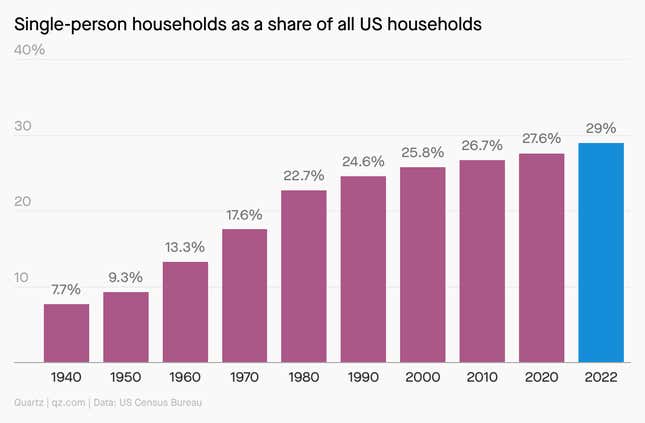Hi Quartz members!
Never in the history of the United States have so many Americans returned from work to an empty home, cooked dinners for one (perhaps even “girl dinners”), watched Netflix by themselves, and slept in the very middle of their queen-sized beds.
It’s a demographic thing. As of the end of 2022, nearly 38 million American households were comprised of just single people. They form 29% of all US households—a record, and way up from the corresponding figure of 13% in 1960. The shift has been gradual, of course, but its consequences for the US economy are profound. “I came to see it as the biggest demographic change in the last century that we failed to recognize and take seriously,” Eric Klinenberg, a New York University sociologist, recently told The Hill.
Klinenberg wrote the book Going Solo in 2012, prompted by an aspect of his earlier research on a fierce Chicago heat wave in 1995. More than 700 people had died that season, in part, he found, because many of them were old and lived alone, with no assistance when they needed it most.
That is, of course, one of the more apparent and problematic effects of this wave of singlehood, and as Americans grow into old age alone, the pressures on the already burdened care system will be immense. But just as solitude is not the same as loneliness, the surge in single-person households is not a wholly worrying development. In fact, some of the factors driving it are reasons to celebrate. And Netflix, at the very least, will be glad that it can sell a pair of subscriptions to two single-person households instead of just one to a cohabiting couple.
CHARTED: THE SINGLETON EXPLOSION

ALL THE SINGLE LADIES
There’s one fundamental reason why the US has so many single-member households today: Women work more.
When women were deprived of most professional opportunities, they were compelled by sheer economics to find partners. But as the workforce became more egalitarian, women were able to choose independent lives. In 1950, the labor force participation rate of women was 34%; by 2020, it was 56%.
Measured by the rise of the working woman, the increase in single-person households is unequivocally good. And it has driven consumption and real estate as well. Think about the manufacturer of that queen-sized bed, who stands to double its sales if two people decide to live solo rather than partner up. The same goes for manufacturers of refrigerators, cars, Pelotons, pancake mix, and many other categories of products. The pool of prospective tenants and homeowners swells; by one estimate, half of all Manhattan homes are occupied by single people.
A further indirect benefit to the economy comes from the savings accounts of one-person households, which tend to save at higher rates, according to a 2019 study, in part because they aren’t able to share financial risk the way families can. Those savings percolate into the wider economy as investment. If the penalty of the single life is the need to spend and save more, it has nonetheless considerably lubricated the wheels of American prosperity.
ONE BIG NUMBER
28%: How much more expensive it is in the US to live alone compared to cohabitating, according to an estimate in a 2021 study.
That number already seems high; then we remember that it draws, in part, on data from a long spell of famously low inflation in the US and across the rest of the world. That era may now have ended for good, economists say, which means the cost of living alone will become steeper still. To make things more difficult, unpartnered adults tend to have poorer economic outcomes when compared to their partnered peers; a Pew Research Center analysis of census data showed that single men earned a media income of $35,600 in 2019, compared to the $57,000 that partnered men made. The US tax code also continues to favor families over single-member households.
In all likelihood, therefore, that 28% figure will rise to a level that makes the single life untenable for hundreds of thousands of Americans. It’s tempting to think of that scenario as one in which economics pushes back against a social trend, but it’s impossible to disentangle these two forces entirely. Economics was embedded in the rise of solo living, after all, so it shouldn’t be surprising if it plays a role in the decline.
ONE 🇫🇮 THING
The US trend towards single-member households is part of a global pattern. The United Nations maintains statistics on one-person households, and most countries that provide regular data show a sure but gradual atomization.
At the very top of the list is Finland, where nearly 45% of all households comprise a single person, up from 28% in 1985. Finnish society has been set up, in some ways, to encourage such households. A “spinster tax,” on unmarried adults over 24, was abolished in 1975, and both social welfare and income tax today are predicated on the individual rather than the family. But as birth rates fall to worrying levels, the government is increasingly stepping in to encourage young families.
Curiously, across the border in Sweden, the current flows the other way. In 2008, 48% of Swedish households were made up of one person; by 2019, that figure had fallen below 40%, according to UN data. One explanation, according to a 2020 paper, is that cuts to the welfare state have increased the risk of poverty for single-adult households, which lack the financial buffer of the family. But through this decade, thousands of immigrants from countries that traditionally favor strong families—Syria in particular—came to Sweden. (Between 2014 and 2016 alone (link in Swedish), nearly 100,000 Syrians moved to Sweden.) These immigrants helped bring down the rate of solo households, but the dip could be temporary. Their children just might grow up and decide to try out the Swedish way of going it alone.
Thanks for reading! And don’t hesitate to reach out with comments, questions, or topics you want to know more about.
Have a singular weekend,
—Samanth Subramanian, global news editor
